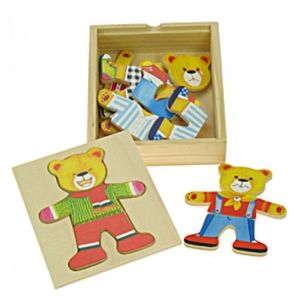Since I’m doing in-home sessions some days, I have to make the most of what I bring. I try to pack what I think will be the “perfect” therapy toy. Truth is that all plans are tossed out the window if my little friend isn’t interested. Then it’s all about improvisation and expertise with what I might have in my bag of tricks. It was after one such session that I thought “Hmm, it might be interesting to someone to know how to take a toy on the fly and turn it into an amazing speech toy.” Well, maybe not amazing, but pretty cool. I had planned a session for my friend Gus*. Gus had no interest in it, but was eyeing a puzzle he happened to have caught sight of at the bottom of my bag. Therefore, without further delay, I bring you Toolbox Tuesday.
Today’s challenge? one small wooden treasure chest and a bear puzzle
Target skill: Receptive Language (think comprehension) & increasing vocabulary
Place said empty wooden bear puzzle in front of your buddy.
Lay out three faces, describing each (ex. Here’s happy bear, here is sad bear, and here is angry bear). Change your voice up- cry for sad bear, smile for happy bear, and make angry eyebrows for angry bear. Ask your friend to pick which his bear happens to be. Is he happy, angry or sad today?
Next lay out two articles of puzzle clothing. I will talk about making this a more difficult task later. Ask your buddy to “find”, “pick out”, “give Mr. Bear the ____”. This is a basic task to get your guy’s language processing center to decipher information and formulate a response.
Making this harder. If your child has his basics down and is ready for a challenge, you can increase the task complexity by either adding additional clothing pieces to choose from OR increasing the characteristics you are asking him to identify.
For example, if you have a field of two items to choose from, he has a 50% chance of choosing the correct item you’ve asked for. By adding the third item, there is more information for him to visually process and identify.
Similarly, placing two items of clothing that belong to the same semantic group (ex. 2 shirts or 2 pants) and increasing the target identifiers (the pajama pants) requires a higher level of identification skill.
Once Mr. Bear is fully dressed, talk about his fine outfit with the child! If he is wearing pajamas, what does your friend think Mr. Bear will do? If he is in his winter clothes, what does that mean? Chat Mr. Bear up about where he goes and what he does.
Vocabulary: Next, you can cover more basic toddler vocabulary: eyes, nose, ears, mouth, arms, paws (hands), tummy, legs, shoes. Following is an example of what this would look like:
Ask your guy to show you where Bear’s eyes are. Make a big fuss when he gets this right, high fives and woo-hoos. Then ask your child where his eyes are. Follow it up with your eyes. You have now practiced finding eyes 3x! If you want to get crazy, get anyone else in house in on the action.
By now you might be wondering what to do with the little wooden treasure chest. I like to keep my puzzle pieces hidden as we work through this kind of task. It eliminates too much info, keeps control of the complexity level (I only take out what I need), and it looks cute. What kid doesn’t like a treasure chest? So parents and SLPeeps, what’s in your toolbox? ooo…. maybe there will be an Iron Therapist show……..
You must be logged in to post a comment.